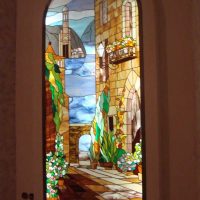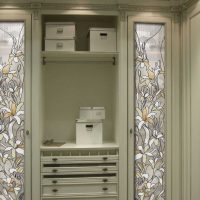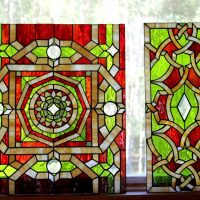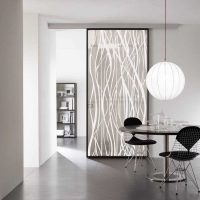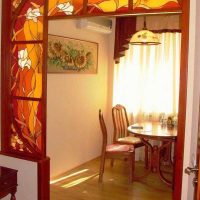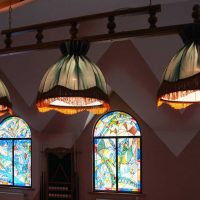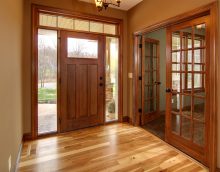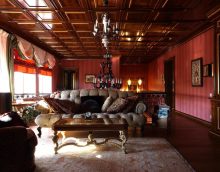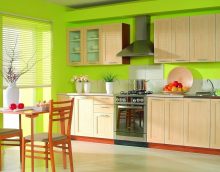Stained glass in the interior. What are they like?
Once, only churches and cathedrals were decorated with such paintings made of colored glass, but since the 19th century, along with the Art Nouveau style, stained-glass windows have also come to the interior of residential buildings, have firmly established themselves in it and have become a method of creating a unique design of the home.
The belief that stained-glass windows in the interior are appropriate only in huge mansions is wrong, they do not have a place in the apartment. Yes, and this pleasure is very expensive. Modern technologies make it possible to make stained-glass windows affordable, harmoniously placing them in the interior of even a small apartment. On the contrary, here the stained-glass windows - in the kitchen, in the bathroom, in the hallway - will become a means of visually expanding the space.

Interior of an apartment with a stained-glass window

Interior design room with multi-colored stained glass

Unusual stained glass in the design of the apartment
Content
- 1 What are stained glass windows
- 2 Stained glass window in the interior
- 3 Window stained glass
- 4 Doors with Stained Glass
- 5 Stained glass ceiling
- 6 Decorative stained-glass windows
- 7 Stained glass and furniture
- 8 Stylish things
- 9 Video: Stained glass do-it-yourself
- 10 50 photos of design ideas for apartments with stained-glass windows:
What are stained glass windows
Initially, the stained-glass window was a carefully selected pieces of glass, interconnected by metal partitions, creating a contour of the picture and serving as a frame for glasses. This is how stained-glass windows were made in medieval times, and this technology is still being used.
This is a classic stained glass window. In addition to such technology, other types of stained-glass windows are distinguished in modern design art.
- Painted. A pseudo-stained-glass window, not made up of individual fragments, but painted with special colors inside the volume contour. Then the pattern is covered with a fixing compound. Its advantage is that it is made quickly, is affordable and gives great opportunities - you can create any kind of drawing for the style of the room, therefore it is one of the most popular types of stained glass windows.
- Sandblasting. It is created by sandblasting glass and is more often used for facades of sliding wardrobes, interior doors, partitions.
- Mosaic. This type of stained-glass window is similar to the classic one, the difference is that the picture is laid out from pieces of glass of the same size.
- Fusing. To create it, colored glass fragments are baked, in addition, small foreign particles can be included in them - for example, pieces of wire.

Room Design with Stained Glass

Color stained glass in the interior
In addition to these, it is necessary to highlight the etched stained glass window, which is based on the ability of hydrofluoric acid to burn glass. Thanks to this, you can create deep contours, and the picture is voluminous. The stained-glass window is painted in the same way as painted.
Important! A variant of the classic stained-glass window is called the Tiffany style. For such mosaic patterns, copper foil is used, due to which the contour becomes thinner, the pattern becomes more elegant. Tiffany's stained-glass windows allow even small glass to be used, so they are more delicate and lightweight.
The stained glass also includes the film look - the easiest and cheapest way to create an imitation of stained glass painting on a transparent surface. Glass is simply pasted over with multi-colored elements cut from a film on an adhesive basis. The contour is applied with special paint.
The various types of stained-glass windows are distinguished by the complexity and cost of work, the materials used, but all of them allow you to create a unique interior.

Interior of an apartment with a stained-glass window
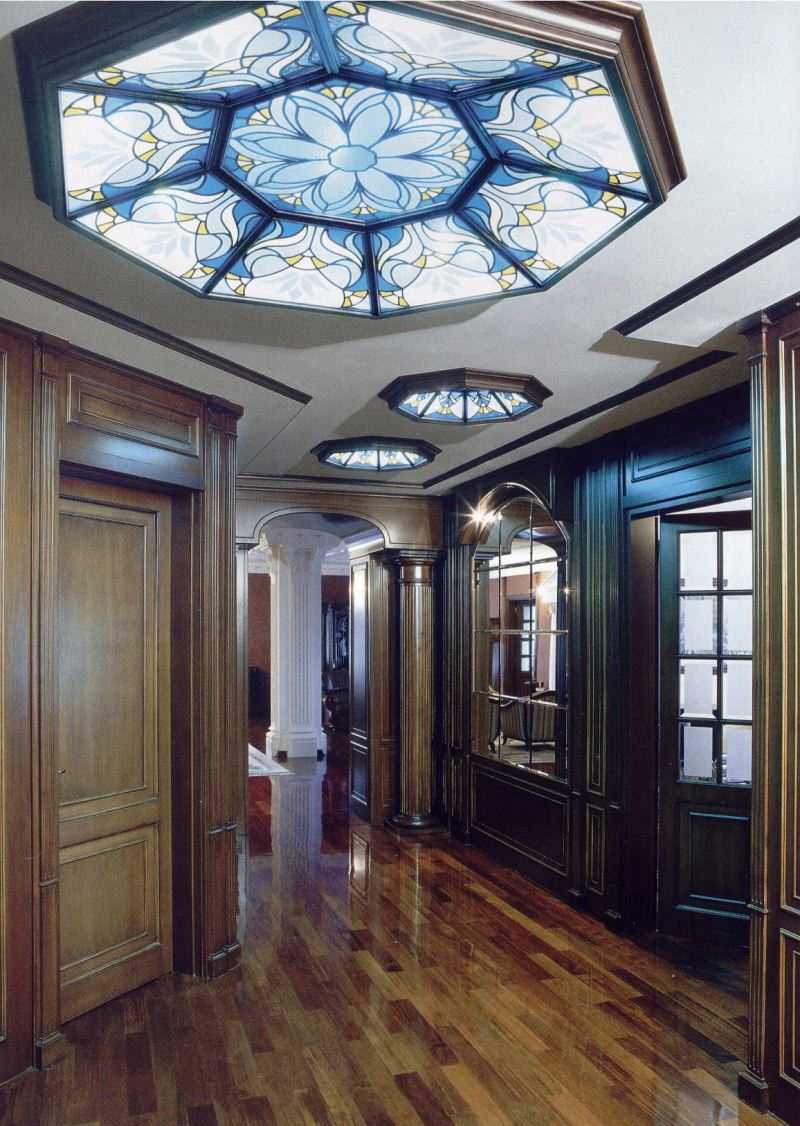
Interior design room with multi-colored stained glass

Unusual stained glass in the design of the apartment
Stained glass window in the interior
Initially, decorative stained glass windows were invented to fill the window opening.Today, not only windows, but also doorways, niches are decorated using glass mosaics, and they are also used to create decor items - lampshades, decorative screens, caskets and vases are created by craftsmen using stained glass techniques.
If we talk about the interior decoration of the home, then the most popular places for using stained glass equipment are:
- window openings - in whole or in part;
- doors
- ceilings;
- niches in the room.
Stained-glass windows will be appropriate in any room - they can be placed both in the bedroom or living room, and in the bathroom or hallway. Only their functional purpose can differ: if in the dining room and the nursery they are designed to become an element of stylization, then the bathroom and hallway they can also have a practical function - to close the room from the view of prying eyes.

Room Design with Stained Glass

Color stained glass in the interior
Window stained glass
The stained-glass window in the window is more appropriate for a country house, mansion. Agree, in a multi-story reinforced concrete tower, such a design somewhere at the level of 10 floors will look ridiculous, but such a design will make a private house noticeable compared to other similar ones. Stained-glass windows in the interior will decorate not only the classic style, but also:
- avant-garde;
- neoclassicism;
- Art Nouveau;
- Art Deco.
Successfully complement the stained glass windows English, Scottish designs of country houses. Floral, landscape plots, sea open spaces - themes for decorating houses in modern styles.
A continuous light belt of bay windows visually expands the room, and a stained-glass window in bright colors will create a special play of light. It is difficult to decorate a room with such windows with curtains: stained-glass windows only slightly muffle bright daylight and hide what is happening inside the room from prying eyes. An enclosed porch with panoramic windows decorated with stained glass painting adjacent to the house will look interesting. Small pieces of glass will create an indescribable atmosphere of something mysterious, magical and at the same time - cozy.
If you want to recreate the decoration of an old castle - Tiffany and fusing styles allow you to turn a country house into a medieval dwelling - stained glass windows with arches will perfectly complement the stylization, not only of the interior decoration, but also of the exterior of the house.
Important! Stained glass windows should be made in rooms where there are no such high requirements for lighting. In the office, for example, it will be dark. The need to strain eyesight, to use artificial light sources during work will become annoying. And in a bright, spacious living room, bedroom, such windows will not cause discomfort.

Interior of an apartment with a stained-glass window

Interior design room with multi-colored stained glass

Unusual stained glass in the design of the apartment
Doors with Stained Glass
This is the most popular way to use stained glass in the interior. Interior doors become a means of stylization, a unique decorative element. In addition, they are a way to hide from prying eyes what is happening behind the door, for example, to the bedroom, the nursery, saving the owners from the need to install a blind door.
In a children's room, a stained glass pattern on a door can be a continuation of a fairy-tale theme chosen for decorating the walls: the windows of the princess’s palace in a children's girl or the porthole of an underwater bathyscaphe or a spaceship in the boy’s bedroom. The avant-garde style in a teenager’s room allows pieces of colored glass inserted in the doors, arranged in a certain order or randomly.
Stained glass doors will decorate the interior in a classic style. Properly selected plots will complement the Mediterranean, oriental designs of the living room.

Room Design with Stained Glass

Color stained glass in the interior
Stained glass ceiling
If several centuries ago the high ceilings of rich houses and theaters were often decorated with glass mosaics, now such a design is once again becoming popular, and not only for styling public institutions - restaurants, theaters, halls in hotels, but also in residential buildings.Modern technologies make it possible to securely fasten sheets of glass at any height. If the backlight is correctly mounted between the main and the false stained-glass ceiling, the effect will be simply amazing.
Important! You can make a stained glass window transparent not the entire ceiling in a room, for example, a living room or bedroom, but only part of a multi-level ceiling - this will make an impression no less.

Interior of an apartment with a stained-glass window

Interior design room with multi-colored stained glass

Unusual stained glass in the design of the apartment
Decorative stained-glass windows
Stained-glass windows in the interior are often used not for practical purposes - to close a window or doorway, but purely in decorative ones. For example, a stained glass panel of irregular shape in a wall niche will make the room more comfortable, lighter, you can also use a picture of small pieces of glass to visually add light to a dark hallway - you just need to put a couple of stained glass panels on the walls.
False windows with a stained glass insert, for example, in the bathroom, will look spectacular. The window in this room is a new trend, and its absence can be replaced by imitation with glass mosaics. Be sure to make the fake window backlight inside, this will add realism, and the stained-glass window will sparkle in a new way.

Room Design with Stained Glass

Color stained glass in the interior
In the spacious living room, the mosaic panel will create the impression of festivity and splendor. It can be placed on one of the walls or using this technique you can build a partition zoning the room. It will be successful to use such a zoning of the living room combined with the kitchen, if the total area is sufficient. You can replace the stained glass partition with a part of the wall that separates the living room from the hallway.
Designers recommend such partitions as a unifying element of two adjacent rooms - they seem to flow one into another, while zoning the space, filling both rooms with light. When the lamps are turned on in the evening, a magical atmosphere is created - a stained-glass window casts light from a lighted room into a dark area.

Interior of an apartment with a stained-glass window

Interior design room with multi-colored stained glass

Unusual stained glass in the design of the apartment
Stained glass and furniture
Stained glass furniture is a great solution for many styles. In the kitchen, cabinets with stained glass facades will be appropriate, in the living room - showcases for dishes, in the bedroom, hallway - doors of cabinets, dressing rooms. For sliding wardrobes often order mirror pseudo-stained glass or sandblasted.
The subject of decor in the bedroom can be a light screen with stained glass inserts. Its purpose is more decorative, although it is able to cover part of the room’s space with itself, while not affecting the illumination of the hidden zone.
Original, stylish - mosaic worktop for a small coffee table. Shelves and cabinet doors in the bathroom are another application of the mosaic technique. Similar items are used to create the exclusivity of the interior.
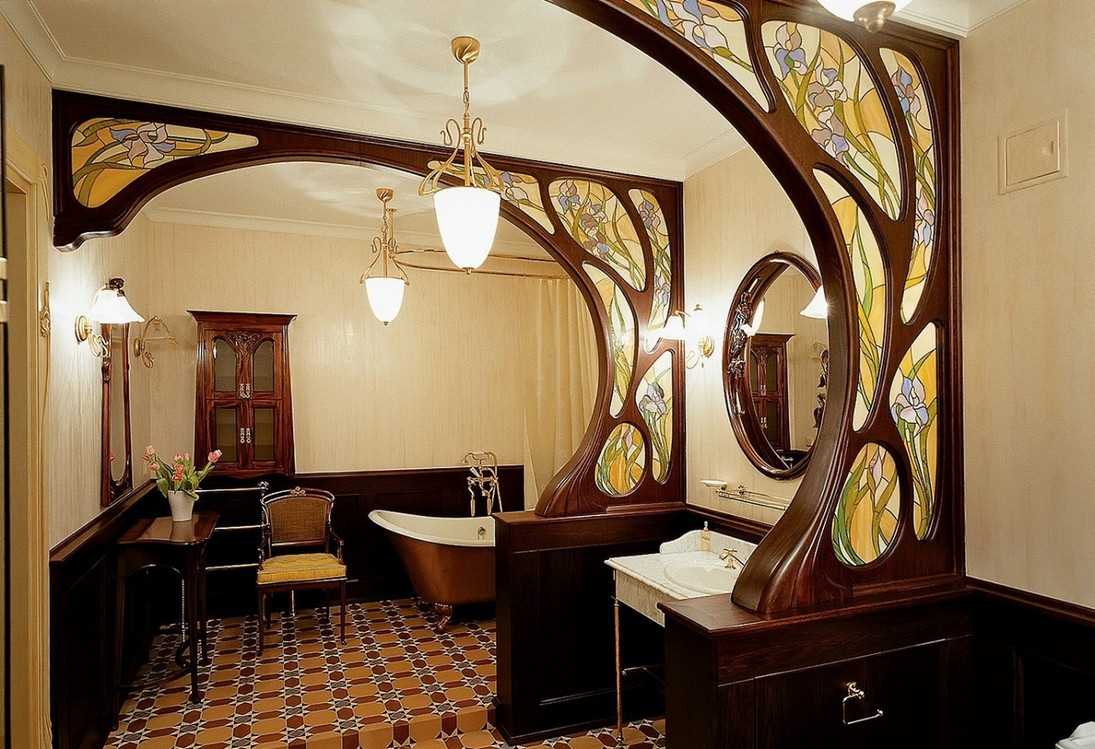
Room Design with Stained Glass
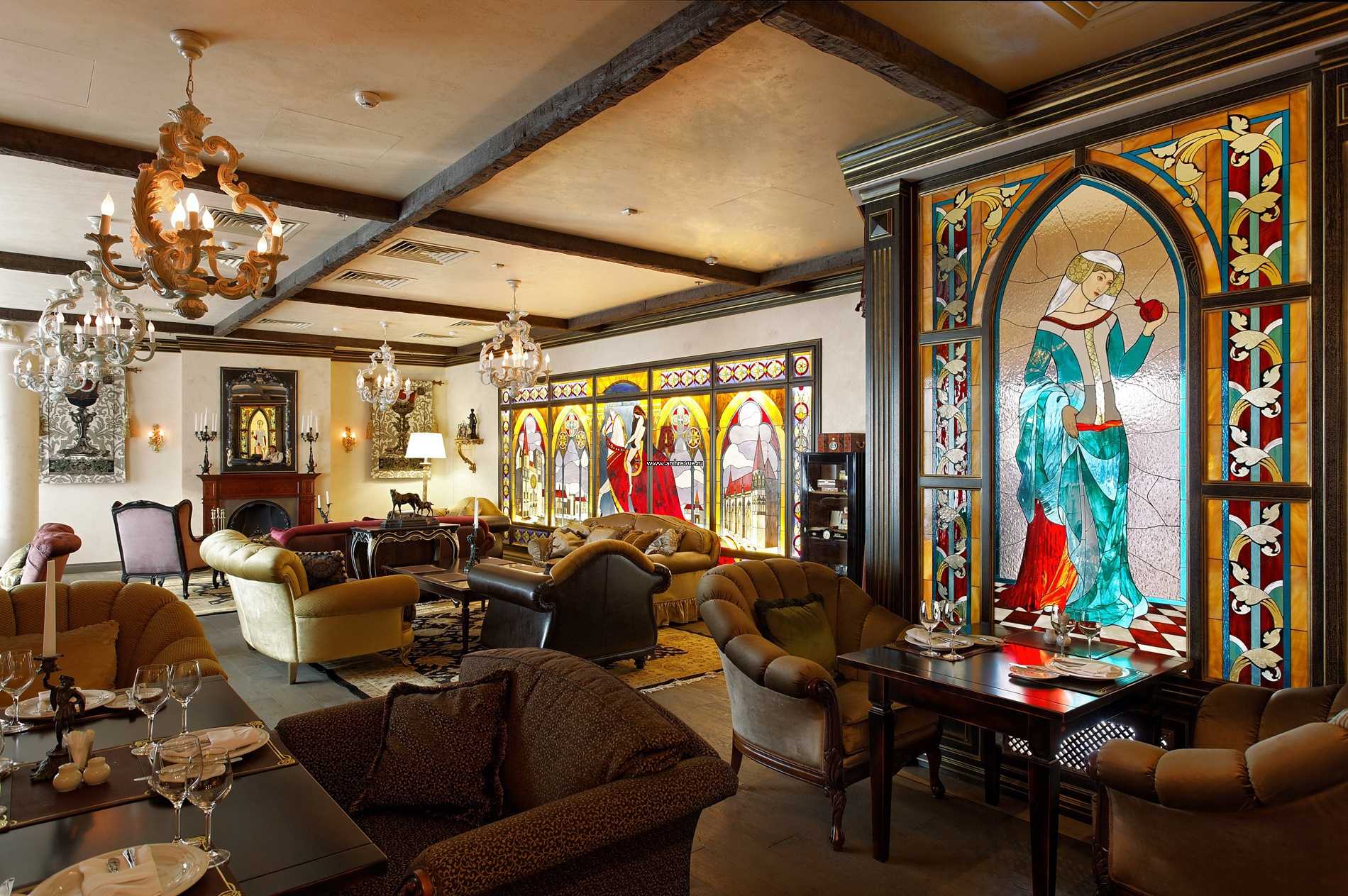
Color stained glass in the interior
Stylish things
Stained-glass windows in the interior are not only huge windows and door inserts. The decoration will be complemented by lamps with a mosaic lampshade, caskets, vases made in this technique. A frame framing a wall mirror will enliven a small entrance hall, just like a stained glass coffee table in a spacious hall.
The main thing is not to overload the space, it’s better to have a few such objects, but they will become an element of design, will be combined with it in color, so as not to get out of the general decoration of the home. The choice of equipment will depend on the design of the room: a classic stained glass window should not be used in modern high-tech styles, minimalism, loft. But this does not mean that glass mosaic and modernity are two incompatible things. Geometric ornaments, suitable plots and modern decoration technologies will help to create an unusual and comfortable home, distinguished by exclusivity and originality.
Video: Stained glass do-it-yourself

















